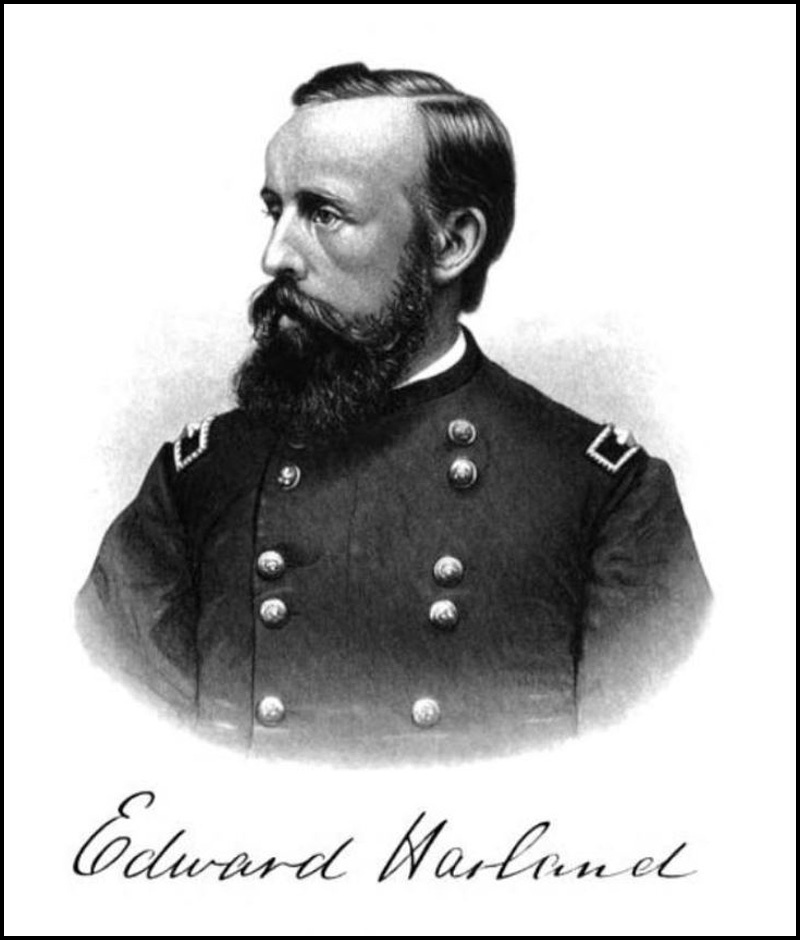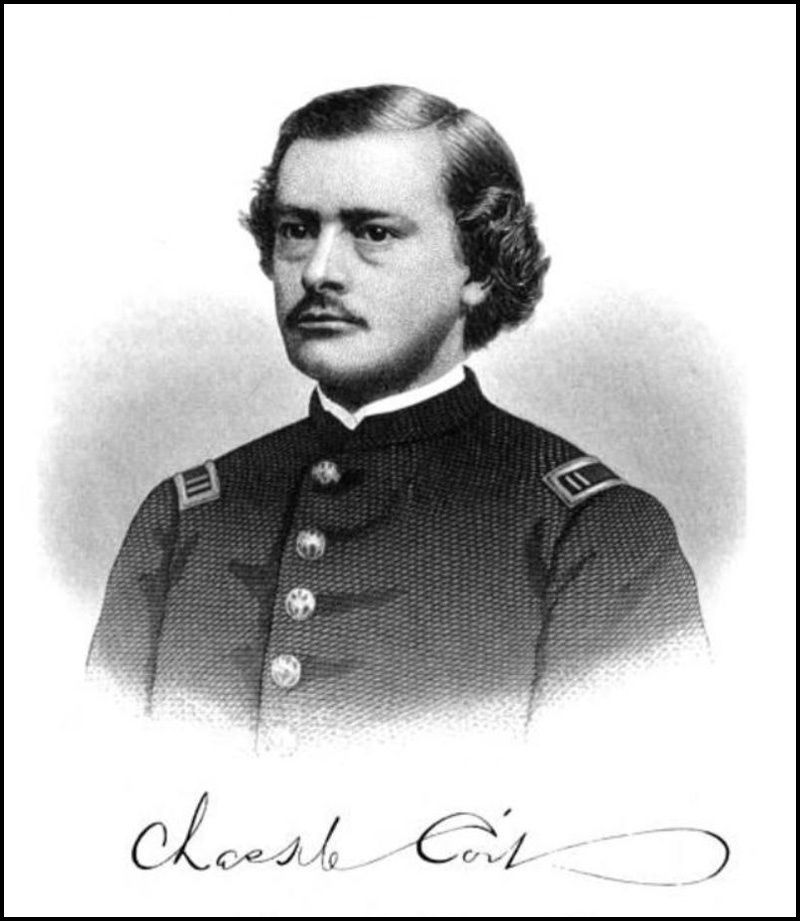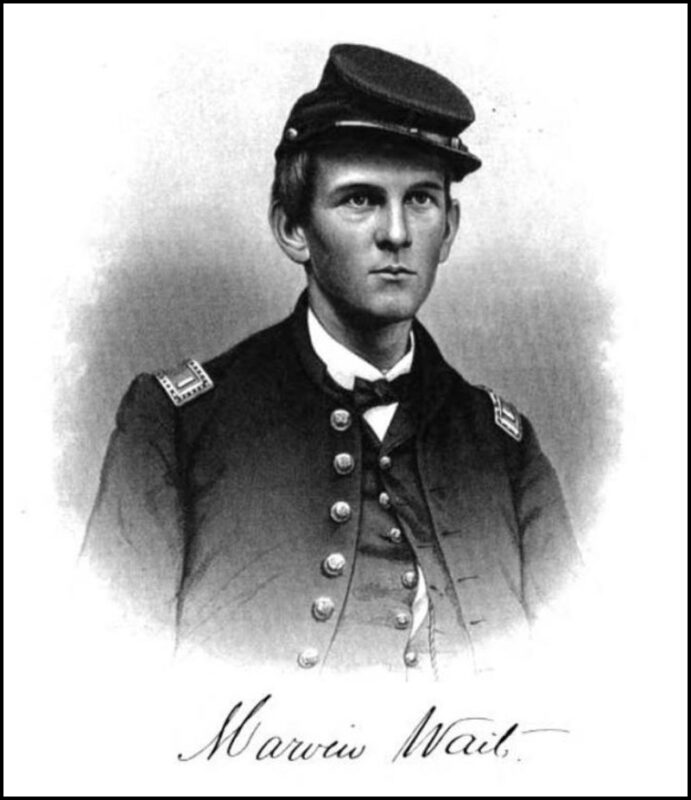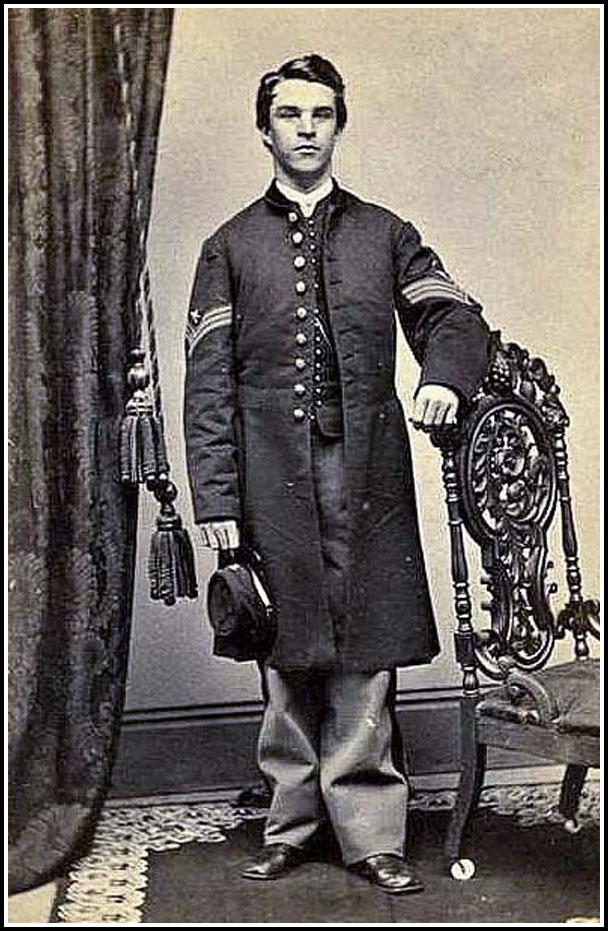Civil War Volunteer Soldiers
Connecticut contributed 30 Volunteer Infantry Regiments, 2 Volunteer Cavalry Regiments and 5 Artillery Regiments to the Union Army during the Civil War period. Each of the regiments were comprised of approximately 1000 men, and were organized into 10 companies each. The soldiers who signed up for the first 3 regiments volunteered for a 3-month period, and the later regiments contained soldiers who volunteered for a 3-year period.
Over the course of the war more than 25% of all Norwich men volunteered for service.
“Approximately 1300 Norwich men served during the Civil War, 1216 in the Army and 84 in the Navy. 156 did not return alive. They served in 20 of the 28 volunteer infantry regiments, 2 heavy artillery regiments, 1 light battery, 1 cavalry regiment and on U.S. Naval Ships. Several served in other state regiments. They fought in 33 battles and engagements. Many were present at Appomattox, VA when General Robert E. Lee surrendered to General Ulysses S. Grant.” (From the Civil War Soldier plaque located on Chelsea Parade in Norwich)
The regiments discussed on this website are the ones in which a large number of Norwich men participated. The intent is to showcase and honor the contributions of these brave men.
2nd Connecticut Volunteer Infantry Regiment
In early April 1861 Frank S. Chester was a bookkeeper at the Thames Bank in Norwich and nephew of Norwich native Reverend Anson G. Chester. However, his life changed dramatically after learning of President Lincoln’s request for troops to join the Union’s effort to abolish slavery. At first, he only received cordial support from his employer when he informed them of his intent to volunteer for a 90-day enlistment. However, like most of the citizens and businesses in Norwich, the bank did generously pledge to continue his salary while he was in service. Upon the recommendation of Colonel Hugh H. Osgood, Chester was given approval to become Captain of the Buckingham Rifles.
James B. Coit, Frank S. Chester, and both leaders and citizens of Norwich quickly enlisted men to fill the slots of a company of men who became the Buckingham Rifles. The day after the mass meeting at Breed Hall, Captain Chester began to train his soon-to-be soldiers. On Monday April 22, 1861, this group of 44 men marched forth from Uncas Hall, amid the enthusiastic cheers and tearful benedictions of an immense crowd. Captain Chester, arm-in-arm with Governor Buckingham, led the company to the Norwich & Worcester Depot. Upon arrival in New Haven, they became members of Rifle Company A of the 2nd Connecticut Volunteer Infantry Regiment (2nd CVI Regiment).

Simultaneously, another company of men was organized in Norwich under the title of Rifle Company A. This group of soldiers, led by Captain Henry Peale, boarded the train for New Haven the next day. Upon arrival these 52 men joined the 2nd CVI Regiment and became Rifle Company B.
Alfred H. Terry was appointed as the commanding officer of the 2nd CVI Regiment, however, Lieutenant Colonel David Young, a lawyer from Norwich, provided the majority of leadership for the regiment due to Colonel Terry being ill during most of the 90-day enlistment period. David Young was the very first man from Norwich to volunteer for service in the Civil War.
All of Captain Chester’s and Captain Young’s men were strongly supported by their wives, families and community of Norwich throughout their term of enlistment. The women sewed their uniforms and sent supplies to them while on their mission.
James B. Coit, the first member and one of the two primary organizers of the Buckingham Rifles, recorded the complete history of the 2nd CVI Regiment. A copy of it can be found HERE.
The 2nd CVI Regiment was mustered into service on May 7, 1861 and was comprised of 10 companies. Eight were armed with Sharps rifles and two with Springfield muskets. After being on the steamer Cahawba, pictured on the left, to Washington D.C. they were given several days of training.
Shortly thereafter, they were sent to a camp near Falls Church, Virginia where they joined together with the 1st CVI Regiment, the 3rd CVI Regiment, the 8th New York Infantry Regiment, the 2nd Maine Infantry Regiment, Tompkin’s New York Cavalry, and Berrian’s New York Cavalry to form Brigadier General Daniel P. Tyler’s brigade. It became the 1st Brigade of General Erasmus D. Keyes’ 1st Division.
The 2nd CVI Regiment took part in the First Battle of Bull Run. According to General Coit, the unit “acquitted itself with great credit, maintaining its regimental formations throughout the action, and demonstrating by its coolness under fire the excellence of its material and the thoroughness of its discipline. Its losses were, one killed and fifteen taken prisoners or missing.”
At the expiration of its 90-day term of service the 2nd CVI Regiment returned to New Haven, where, on August 7, 1861, its men were mustered out. Some men chose to close out their military career, but most of them volunteered to use their experience, training, and discipline in 3-year enlistment CVI regiments. These men became valuable officers; many were decorated with spurs and others with stars for gallant and meritorious service.
“History of the Second Connecticut Volunteers”, by General James B. Coit
“The Norwich Memorial: The Annals of Norwich, New London County, Connecticut in the Great Rebellion of 1861-65”, (1873), page 261, by Malcom McGregor Dana
The complete list of sources may be found by clicking the “Bibliography” button, and, then typing “2nd Connecticut Volunteer” in the SEARCH box.
3rd Connecticut Volunteer Infantry Regiment
The volunteer companies that made up the third 90-day regiment from Connecticut began their organization almost simultaneously with those which made up the first and second. President Lincoln’s original call for troops only requested one regiment from Connecticut, but the eagerness of Connecticut men to enlist induced Governor Buckingham to personally intercede with the President for the acceptance of at least three regiments, and this request being granted, the 3rd CVI Regiment was very soon filled to the maximum.
3rd Connecticut Volunteer Infantry Regiment
*Place cursor over photo to enlarge
Even as the first two Norwich companies of soldiers were being added to the 2nd CVI Regiment, a third group of men were volunteering to become members of the Norwich Rifles. Edward Harland, a Norwich lawyer, was chosen as leader of the Norwich Rifles. He later became a seasoned Brigadier General in the Union Army. Also among those in the company were Charles A. Breed, who later fought with the 8th CVI Regiment, and Private David C. Case.
The Norwich Rifles were sent to Hartford only seven days after the first two groups left Norwich. They became Rifle Company D of the 3rd Connecticut Volunteer Infantry Regiment on May 14, 1861.
Nine days later, they sailed from New Haven to Washington on the steamer Cahawba, the same troop transport vessel that had carried the 2nd CVI Regiment several days earlier. Once they arrived in the Washington area, they were combined with the 1st CVI Regiment, and 2nd CVI Regiment as a part of Daniel P. Tyler’s 1st Brigade.
The 3rd CVI Regiment fought bravely during the First Battle of Bull Run . In the official after-action report the brigade commander, Colonel Erasmus D. Keyes noted that :
“The gallantry with which the Second Regiment of Maine, and the Third Regiment of Connecticut Volunteers, charged up the hill upon the enemy’s artillery and infantry was never, in my judgment, surpassed.”
David C. Case of Company D, 3rd CVI Regiment died after being struck by a Confederate canon ball. He was the first of Norwich’s men to die in battle.
“History of the Third (Three Months) Connecticut Volunteers”, State of Connecticut
“Third Connecticut Regiment Infantry, Camp Douglas, 1861”, by Mathew Brady
The complete list of sources may be found by clicking the “Bibliography” button, and, then typing “3rd Connecticut Volunteer” in the SEARCH box.
Private David C. Case
David C. Case, son of Deacon Samuel Case of Norwichtown, was a private in Company D, 3rd Connecticut Volunteer Infantry Regiment. He was killed in the First Battle of Bull Run by a cannon ball on July 21, 1861. David was 26 years old and was the first soldier from Norwich killed in the Civil War.
Three months after his death a resolution was passed at a Norwich town meeting, thanking Norwich’s brave sons, pledging support to the United States’ government and expressing the city’s pride and support regarding Norwich’s boys in uniform.
David married Mary Jane Burrows in 1857. They had two daughters, Libbie who died before her 2nd birthday and Jennie. Jennie was less than 7 months old when her father died, however, she lived to adulthood, was married, had three children and lived to the age of 92. David’s wife.
Mary Jane married George W. Briggs two years after David’s death, however, she and George later divorced.
David Case is buried along with his wife and family in Yantic Cemetery.
“History of Norwich, Connecticut: From Its Possession From the Indians, to the Year 1866”, page 682, by Frances Manwaring Caulkins
FindAGrave.com
The complete list of sources may be found by clicking the “Bibliography” button, and, then typing “David C. Case” in the SEARCH box.
8th Connecticut Volunteer Infantry Regiment
The 8th Connecticut Volunteer Infantry Regiment was organized at Camp Buckingham, Hartford in September 1861. It was commanded by Colonel Edward Harland of Norwich, before he became a brigade commander. The regimental adjutant was Captain Charles M. Coit, also from Norwich. Most of the men of the 8th CVI Regiment were from merchants and farmers from northern Hartford and Litchfield counties. However, the regiment was heavily populated with men from Norwich. The men who volunteered for this unit committed to a 3-year term enlistment.

Col Edward Harland

Capt Charles M. Coit

Capt John A. McCall

Lt Marvin Wait

Sgt Charles Walker

Sgt Major Forrest Spofford
From March 1862 through April 1865 they were engaged in ten major battles. The complete list of their battles can be found HERE. Over its three-years of existence 112 men were mortally wounded and killed, and another 132 died of disease. The 18th CVI regiment mustered out of service on December 12, 1865.
Soldiers from Norwich contributed to the 8th CVI regiment at all levels. Only a few of their many contributions are listed below :
Colonel Edward Harland : 8th CVI Regiment Commander and later a brigade commander at Antietam. A more detailed list of his contributions can be found HERE.
Captain Charles M. Coit : Regiment Adjutant & Captain of Company B : He was the secretary treasurer of the Chelsea Bank and a Yale graduate prior to enlisting. He fought in every 8th CVI regiment major battle and was wounded at the Battle of Battle of Fair Oaks in early 1865. After the end of his military career, he was brevetted a lieutenant colonel.
Lieutenant Marvin Wait : The only son of a prominent Norwich attorney, was mortally wounded leading his men at Antietam. Lieutenant Wait was first wounded in one arm, and continued to fight until further wounds forced him to be carried from the field and laid down near a fence. There another bullet ended his life.
Sergeant Charles H. Walker : He was commended for his role in saving the U.S. flag carried by the regiment. One color bearer after another had been shot down when Walker seized the flag and carried it through the remainder of the fighting. Miraculously, Walker survived without a scratch.
Sergeant Major L. E. Forrest Spofford : He was a graduate of the Norwich Free Academy and enlisted for 3-years of service at the age of 18. Spofford lost his left arm at Antietam during a charge by the 8th CVI regiment. However, he did not resign from duty. Eight months later he fought at Walthall Junction and was wounded again. At his discharge, he was the sergeant major of the regiment, the highest ranking non-commissioned officer. After his return to civilian life, he served as an assistant librarian in Norwich’s Otis Library.
Lieutenant John A. McCall : Before enlisting, he was a carpenter at the Yantic Woolen Mill. McCall was wounded in the thigh at Antietam and taken prisoner. Shortly thereafter he was paroled and returned to duty in the 8th CVI regiment.
Lieutenant Alfred M. Goddard : Alfred M. Goddard was born in Ohio but moved to Norwich with his parents at a very young age. His grandfather was Calvin Goddard, a former mayor of Norwich. Alfred was a free-spirited young man who travelled the world while working for the Williams, Haven and Company, the longest operating whaling firm in southeastern Connecticut. One of his employers, Henry P. Haven, was the Norwich’s famed historian, Frances Manwaring Caulkins’, half-brother.

Upon reading news of the war Goddard returned to Norwich from the Sandwich Islands, where he had been working, to enlist in the Union Army. In his journal, Goddard wrote “I would go through anything to get upon the battle field” and later wrote “It seems strange that the country should have been ruled so long by this small party [slave holders]. But the time for a change has come, and I think the curse of slavery will now be removed from our beautiful land”.
In July 1863 he was commissioned as a First Lieutenant in Company B, 8th CVI Regiment, however, was assigned as General Harland’s assistant brigade adjutant. He was unhappy serving as a staff officer and longed to join the ranks of his fellow soldiers on the battlefield. In March 1864, his request was granted and a few weeks later, on May 7, 1864, the 8th CVI regiment led a reconnaissance of the enemy’s line prior to the Assault on Petersburg in Virginia. The battle was fierce and the regiment repeatedly charged the foe until their ammunition was exhausted. The regiment was relieved by order, and returned from the bloody field to the cheers of the whole brigade. While bravely fighting and cheering on his men in this his first battle, Lt. Alfred M. Goddard was mortally wounded by a bullet and fell to the ground. He died two days later.
Wikipedia
“The Norwich Memorial: The Annals of Norwich, New London County, Connecticut in the Great Rebellion of 1861-65”, (1873), pp 172, 229-234, Malcom McGregor Dana
The complete list of sources may be found by clicking the “Bibliography” button, and, then typing “8th Connecticut Volunteer” in the SEARCH box.
Battle OF Antietam : September 16-18, 1862
The Battle of Antietam was the bloodiest day in American history, with 23,000 of the 120,000 engaged killed, wounded or missing. Both the 8th and 16th CVI Regiments fought at the battle under the leadership of Norwich’s Colonel Edward Harlan
The monument, shown on the left, was erected on the Antietam battlefield in 1894 by surviving members of the four Connecticut Regiments who fought there.
During the final phase of the battle of Antietam Colonel Harland led the 8th CVI, 16th CVI and 4th Rhode Island Infantry Regiments. Their goal was to push into the village of Sharpsburg and cut off the Confederate’s army from retreat. The attack failed due to arrival of additional southern troops and mistiming. The plan was for the three regiments to advance simultaneously, but, the 8th CVI regiment was the only one to attack.
Meanwhile, the 8th Connecticut continued their assault, unaware they were not supported by other units. They gallantly charged and overran a battery of Confederate artillery. They were in advance of any other troops, however, and soon found themselves alone and exposed to attack on two sides. Forced to retreat, the regiment left half of its 350 men dead or wounded on the field.
The cost of the Battle of Antietam for the 8th CVI Regiment was high. Approximately 34 were killed,149 wounded, and 62 missing. Nearly half of the regiment’s leadership was killed.
“Deadliest Day: Norwich at the Battle of Antietam, Sept. 17, 1862”, (04/18/2017), by Dale Plummer, The Bulletin
“8th Connecticut Volunteer Infantry Regiment”, by Antietam.StoneSentinels.com
Lieutenant Marvin Wait
At the tender age of nineteen Marvin Wait was the youngest officer in the 8th Connecticut Volunteer Infantry Regiment and the first commissioned officer from Norwich to be killed during the Civil War.
One of his fellow officers on field of combat, Lieutenant Jacob Eaton, wrote:
“A braver man than Marvin Wait never confronted a foe; a more generous heart never beat; a more unselfish patriot never fell. Connecticut may well cherish and honor the memory of such sons.”
So … how did such a young man from Norwich become a hero?
Place cursor over any image to magnify
IN MEMORY OF
LIEUTENANT
MARVIN WAIT
CO. A 8TH REG’T CONN. VOL.
BORN AT NORWICH
JAN 21, 1843
KILLED WHILE GALLANTLY
LEADING HIS MEN IN THE
BLOODY CONFLICT AT
ANTIETAM MARYLAND
SEPT. 17, 1862
Epitaph on Marvin Wait’s Memorial
Place cursor over image to magnify
Both Marvin Wait’s father and paternal grandfather were prominent lawyers in New London County. Accordingly, everyone believed that young Marvin was destined to follow in their prestigious footsteps. He displayed a keen, inquiring mind throughout his education at the Norwich Free Academy (NFA) in Norwich, the Williston Seminary in Easthampton, Massachusetts, and Union College in Schenectady, New York.
At NFA he participated in sports and all the pastimes of youth with hearty zest. It was written that he was gifted with a ready wit, unusual conversation powers, and a keen perception of the humorous. He was always prepared with a playful answer or sparkling repartee.
Marvin entered Union College in the fall of 1860. While there he showed the same mental and social characteristics which had distinguished his prior student life. He made warm and earnest friends, and took a high rank in all classical and literary studies.
After returning to Norwich in the spring of 1861, he sailed to Europe and began a five month tour of Belgium, Holland and England. While there Marvin learned that Civil War had erupted when Confederate soldiers bombed Fort Sumter in South Carolina.
Info Source 1 (page 4) tells us:
“On his return from Europe he was very solicitous to enter the army, but was finally induced to resume his course in college in the fall of 1861. But he was not willing to remain a mere spectator of the great struggle for national unity and life. His noble heart kindled with a manly, unselfish desire to aid in defending and perpetuating our Republican Democracy. He remained but a short time in college, when he and several other students withdrew, and entered the army.”
Marvin Wait enlisted in Captain Ward’s Company D of the 8th Connecticut Volunteer Infantry Regiment as a private on October 5, 1861. He was assigned the duties of an Orderly to his childhood mentor, Colonel Edward Harland.
At the age of 18, on December 24, 1861 Marvin was promoted to 2nd Lieutenant in the Signal Corps. His first combat experience took place at the Battle of Roanoke Island in North Carolina on February 9, 1862. While he was aboard the steamer “S. R. Spaulding” Lt. Wait was employed sending and receiving messages.
In March 1862 Marvin served aboard General Burnside’s flagship during the Siege of Fort Macon North Carolina. In their capacity as Signal Corps officers, Lieutenant Wait and Lieutenant William J. Andrews observed and evaluated the trajectory of his fellow soldier’s artillery shells that were intended to strike their enemies. Lieutenant Wait signaled the Union Army’s field artillery officer-in-charge with guidance and accuracy corrections. The Confederate’s proposition to surrender, and reply from General Burnside were sent through Lieutenant Wait. Marvin was awarded a “Signal Battle Flag” by the head of the Signal Department for his meritorious conduct during the Siege of Fort Macon.
In June 1862 Marvin was promoted to 1st Lieutenant. In July 1862, he was granted a leave of absence to return the body of his close friend, Lieutenant Charles A. Breed, to Norwich. His friend had died of typhoid fever in Newport News, Virginia. Marvin attended Breed’s funeral in Norwich on August 2, 1862. He left home on August 19, 1862 and returned to the 8th Connecticut Volunteer Infantry Regiment in time for the evacuation of Fredericksburg and the march to Antietam Creek, near Sharpsburg, Maryland.
The September 17, 1862 battle at Antietam remains the bloodiest day in American history, with a tally of 22,727 dead, wounded or missing on both sides. Although the Union Army suffered heavier casualties than the Confederates, the battle was a major turning point in the Union’s favor.
The cost of the Battle of Antietam for the 8th CVI Regiment was high. Approximately 34 were killed, 149 wounded, and 62 missing. Nearly half of the regiment’s leadership was killed.
During the terrible and mighty conflict, Lt Marvin Wait’s courage, valor, and patriotism, reached their sad but sublime consummation. Here he wrote his claim to honor and gratitude with his own blood. He wrote so deeply and indelibly the hand of time will never erase it.
Being under fire, a canon ball from a rebel battery struck in the midst of his company, killing three men, and severely wounding another. Lieutenant Wait was covered with blood and earth. The shot produced some confusion in the company, and several of the men commenced giving way. He sprung to his feet amid a shower of bullets, and ordered every man back to his post, in the most gallant manner.
After the battle Captain Hoyt of the 8th CVI Regiment wrote:
“Lieutenant Marvin Wait fell at his post while urging on his men into that terrible storm of shot and shell. He was a brave, noble-hearted man, and highly esteemed by all who knew him.”
The unflinching hero was first wounded in the right arm, which was shattered. He then dropped his sword to his left hand; he was afterwards wounded in the left arm, in the leg, and in the abdomen. He was then assisted to leave the line by private King, who soon met Mr. Morris, the brave, indefatigable Chaplain of the Eighth Regiment. The Chaplain then conducted Lieutenant Wait to a fence behind the line of fire and private King returned to his company.
Lieutenant Wait’s last words to private King were, “Are we whipping them?”
After the battle, Captain Charles M. Coit wrote: (Info Source 1 ppg 10-11)
“If Lieutenant Wait had only left the battle of his own accord when first hit in the arm, all would have been well, but he bravely stood to encourage his men still further by his own example, and at last nobly fell pierced by bullet after bullet.”
Marvin Wait of Norwich Connecticut was a hero in the truest sense of the word.
“Memorial of Marvin Wait, (1st Lieutenant Eighth Regiment C. V.,) Killed at the Battle of Antietam, September 17th 1862”, (1863), by Jacob Eaton
“The Norwich Memorial : The Annals of Norwich, New London County, Connecticut in the Great Rebellion of 1861-65, (1873), ppg 45, 211-218, Malcom McGregor Dana
“Deadliest Day: Norwich at the Battle of Antietam, Sept. 17, 1862”, (04/18/2017), by Dale Plummer, The Bulletin
“The Norwich Memorial : The Annals of Norwich, New London County, Connecticut in the Great Rebellion of 1861-65, (1873)”, page 332, Malcom McGregor Dana
Marvin Wait’s Gravesite in Yantic Cemetery, by Bob Dees
The complete list of sources may be found by clicking the “Bibliography” button, and, then typing “Marvin Wait” in the SEARCH box.